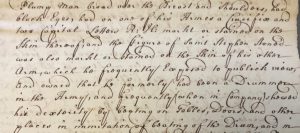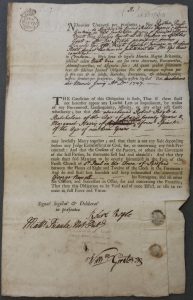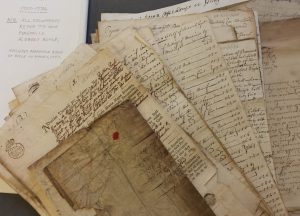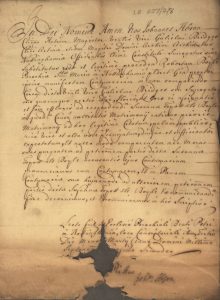February 14, 2017, by Kathryn Steenson
Robert Boyle, the Biggleswade Bigamist
With dark eyes, broad shoulders and a black suit with a gold-embroidered waistcoat, former soldier Robert Boyle cut a dashing figure. He used his confidence and charm to win the hearts of young ladies wherever he went – and then ruined them.
Bigamist
Five days into her marriage, Susannah Boyle was confronted with the reality that her husband, and her fortune, were gone. It was an abrupt and unhappy ending to a whirlwind romance.

Description of Boyle taken from the Instance cause of Susannah Topott otherwise Boyle against Robert Boyle. (Ref: AN/LB 237/11/1-28)
At the beginning of August 1727, the landlord of the White Lion in Nottingham rented a room to 21-year-old Boyle and his servant. Boyle was sociable and generous, and soon had an audience for his stories about life as an Army drummer, which he often accompanied by beating a rhythm on tables and walls. He also showed off the crucifix and letters R.H. ‘marked or stained in or on the skin’ on one arm, and a tattoo of the stoning of St Stephen on the other arm. If he was aware that such unusual and distinctive markings could be used to identify him, it didn’t worry him.
One of Boyle’s drinking companions was Beaumont Toppot, a widower living in St Mary’s in Nottingham. Believing Boyle’s tales about being heir to a considerable estate, Toppat encouraged a relationship between his daughter Susannah and Boyle. On the 12th August 1727, Boyle applied for, and received, a marriage licence. This allowed couples to marry quickly with minimal publicity because Banns did not have to be read in church for three weeks before the ceremony. Whilst there are many innocuous reasons for marrying by licence, Boyle’s motivations were anything but.
Boyle and Susannah married the day after being granted the licence. Within a week of living as man and wife, Boyle took the £150 Susannah had been given on her wedding, and fled Nottingham.
It was the second time that summer he had done this.
Swindler
Earlier that year, Margaret Harris had been a 19-year old living in Bedfordshire. According to an anonymous letter, her beauty brought her many admirers. She was also reputed to have a considerable fortune. Boyle seems to have arrived in Biggleswade as suddenly as he did in Nottingham, with no information as to his previous whereabouts.

Marriage bond of Robert Boyle of Biggleswade, bachelor, aged 21 and Margaret Harris of Ampthill, spinster, aged 19 years, 12 June 1727 (Ref: AN/LB 237/11/1-28)
He probably made Margaret’s acquaintance through her brother-in-law, an Innkeeper named William Greatorex. In March 1727, this dark-eyed young man with a crucifix and the letters R.H. tattooed on his arm and a fondness for gold accessories began courting her. On 12 June 1727, Boyle applied for and received a marriage licence; the following day he and Margaret were wed. As a minor (under 21), the bride needed permission to marry and that was granted by William Greatorex, presumably as her parents were deceased.
Whether or not claims of Margaret’s £400 fortune were true, Boyle was only officially accused of taking £60 when he abandoned her, literally by the side of the road ten miles from home, after only month of marriage.

All documents relating to Toppot v Boyle, with a helpful note that all the aliases relate to the same man.
To make matters worse, poor Margaret was pregnant. She gave birth to a son, John, in March 1728. By the time Susannah’s case was heard in the ecclesiastical court, Greatorex had died, leaving Margaret and her widowed sister Elizabeth to support themselves by running a coffeehouse.
Excommunicant
After he’d abandoned his second wife, reports circulated in Biggleswade and Nottingham that Boyle’s real name was Handleby (hence the R.H. tattoo), and that he was a serial bigamist who travelled around using the aliases Boyle and Hannibal in an attempt to conceal his crimes. We don’t hold baptism records but a quick check on FreeReg shows Margaret’s baby was baptised on 29th March 1728 with no father listed and an alternative (mis-transcribed) surname of ‘Hannibal’.
Susannah successfully petitioned to have her marriage annulled. All the surviving documentation – the copy marriage licences and registers, depositions and letters from friends and family of both women submitted as evidence, the charges against Boyle – comes from her case in the ecclesiastical courts in 1733 to prove Boyle was a bigamist.
Boyle was ordered to pay £30 court costs and excommunicated in absentia. He never saw his wives or son after abandoning them. Nothing more is known about what happened to him, or if he duped any other women. Likewise, once Susannah’s case was finished, she vanishes from history. Women with that name appear later in Nottingham marriage registers, so perhaps she did eventually have a happy family life. The same is less likely for Margaret and her son. In 1733, aged 26, her marriage was considered valid, leaving her unable to remarry. If she proved that she was not Boyle’s first wife, the case records would be with the Bedfordshire Archdeaconry Court archive, but there’s no suggestion she’d attempted an annulment.
Documents relating to Toppot v Boyle are in the archive of the Archdeaconry Court of Nottingham, in AN/LB 237/11/1-28, AN/LB 237/2/8, AN/LB 237/4/10. All of them can be viewed in the Reading Room at King’s Meadow Campus. If you’re interested in finding out more about our holdings, visit our website, read our newsletter Discover, or follow us @mssUniNott.



Susanah Toppot/Boyles father mentioned here, Beaumont Toppot, was my 6 x great grandfather and Susannah remarried at St. Mary’s church, Nottingham. Marriage licence dated 01/04/1733 – John Reeves of Nottingham, glass founder age 24 of St. Mary, Nottingham and Susannah Topott , Widow, aged 23 also of St. Mary, Nottingham – Bond by Beaumont Toppot of Nottingham, Confectioner
Thank you Adrian, it’s nice to know what happened to her after the case. I hope her second marriage was much happier than her first!